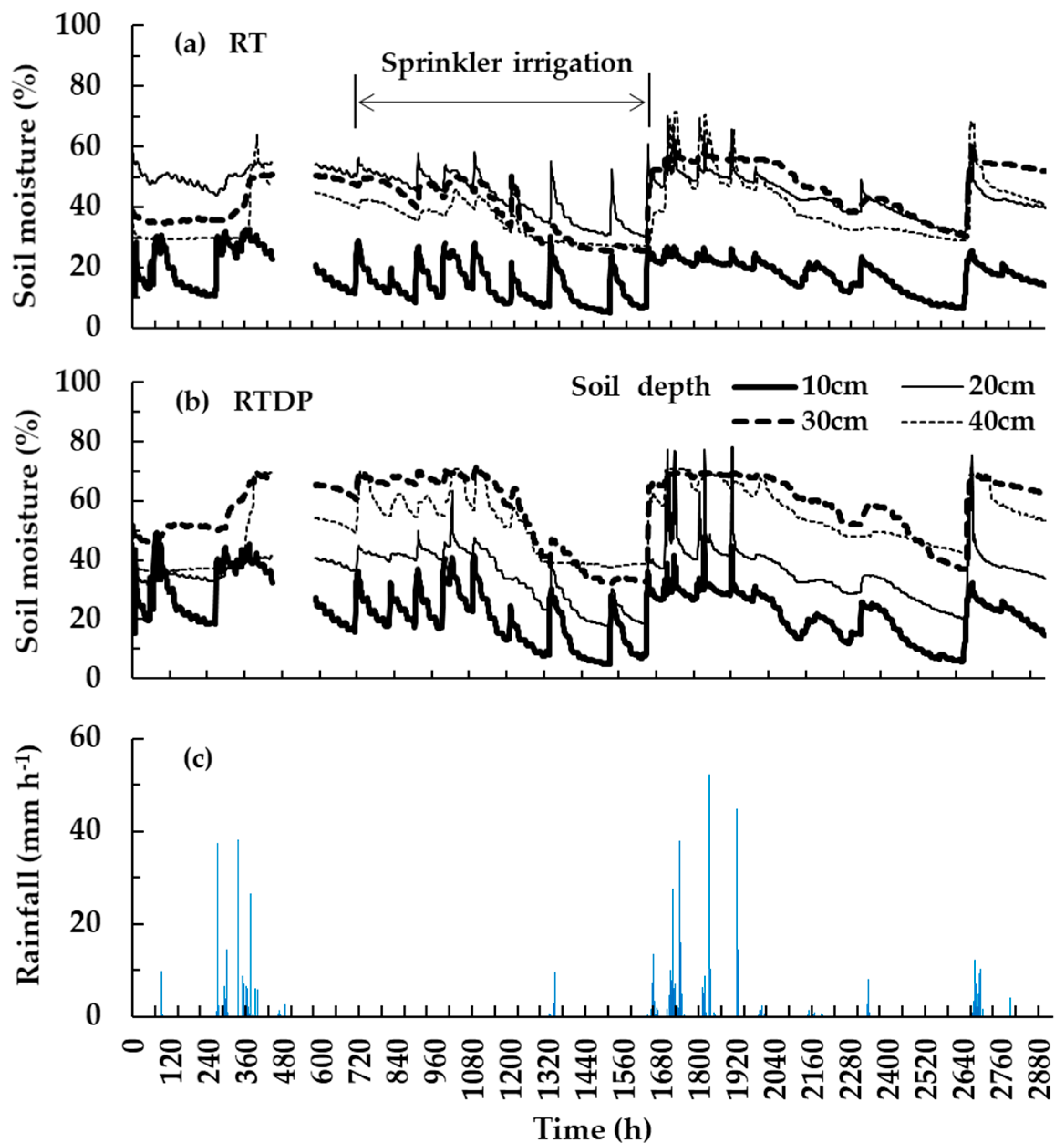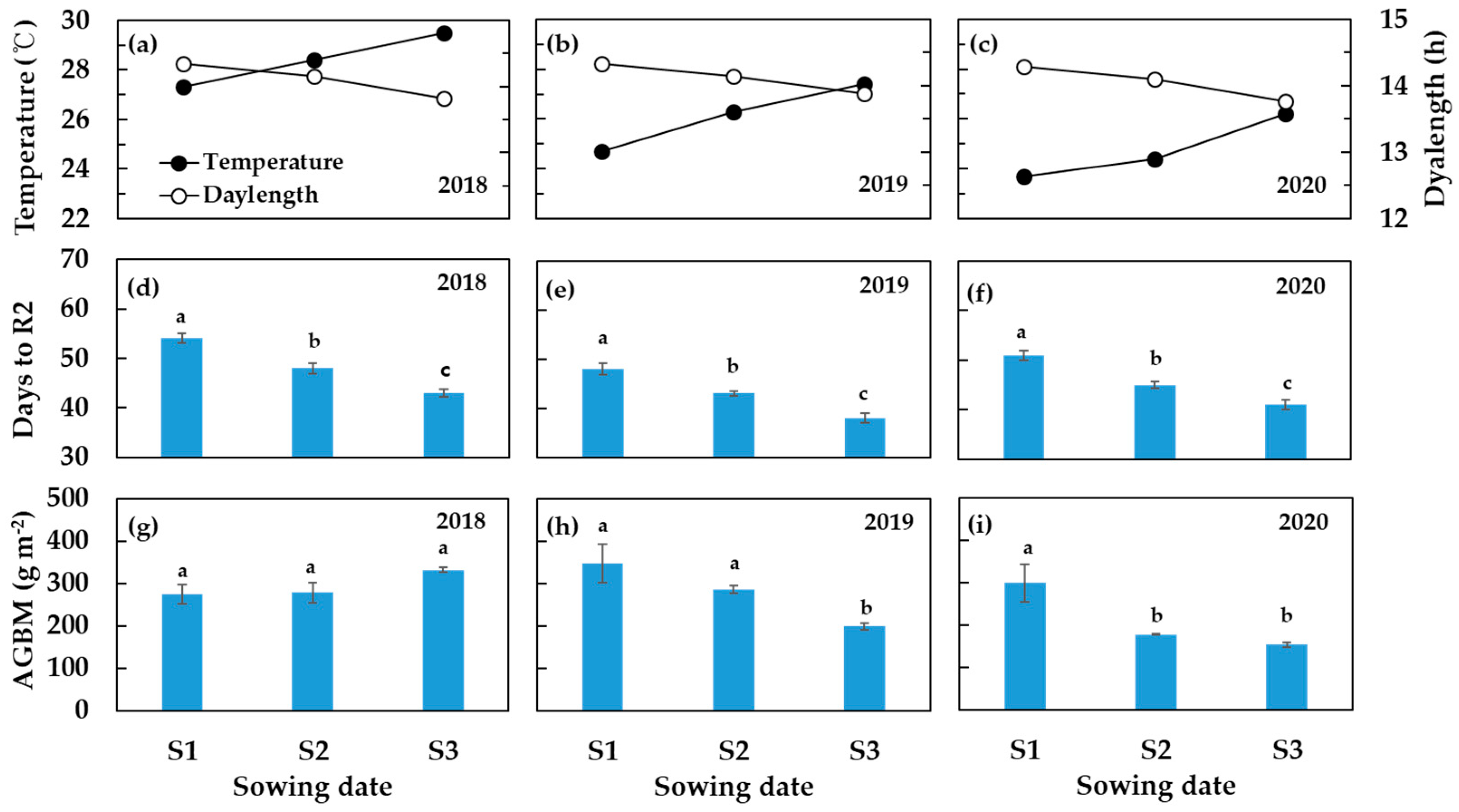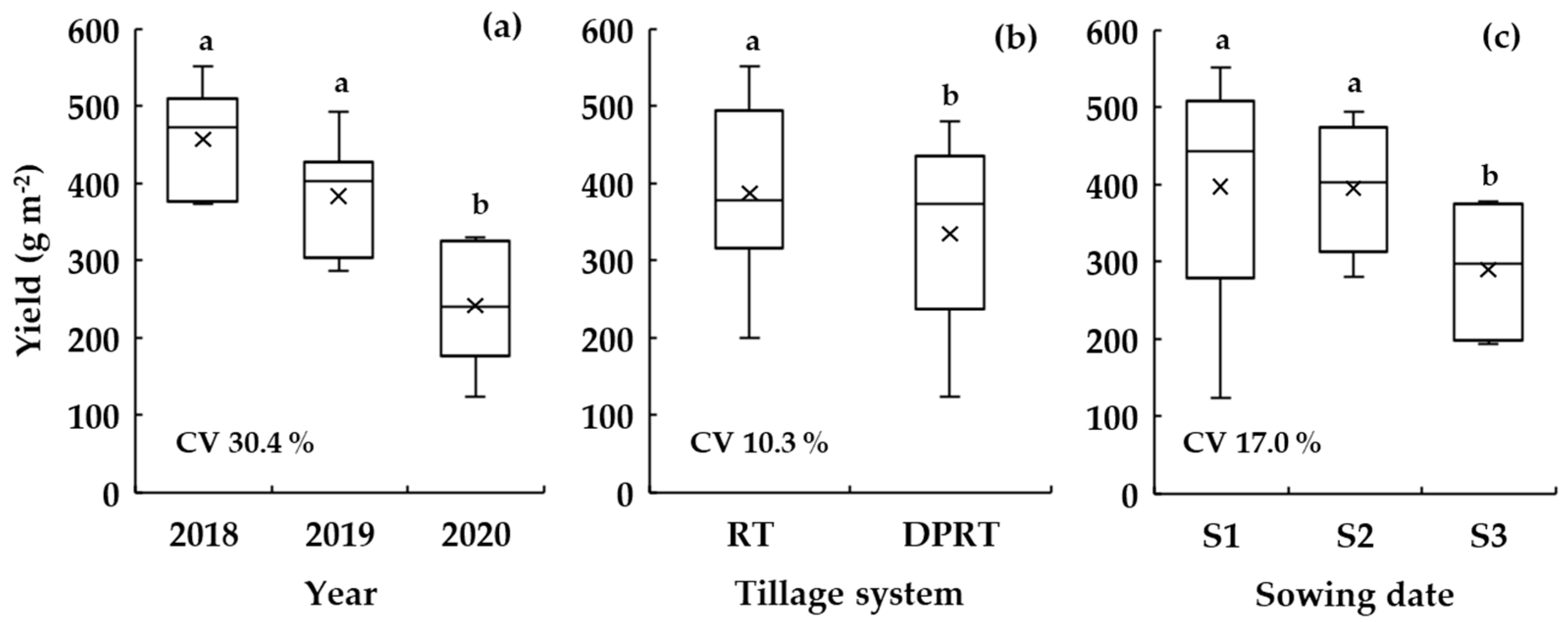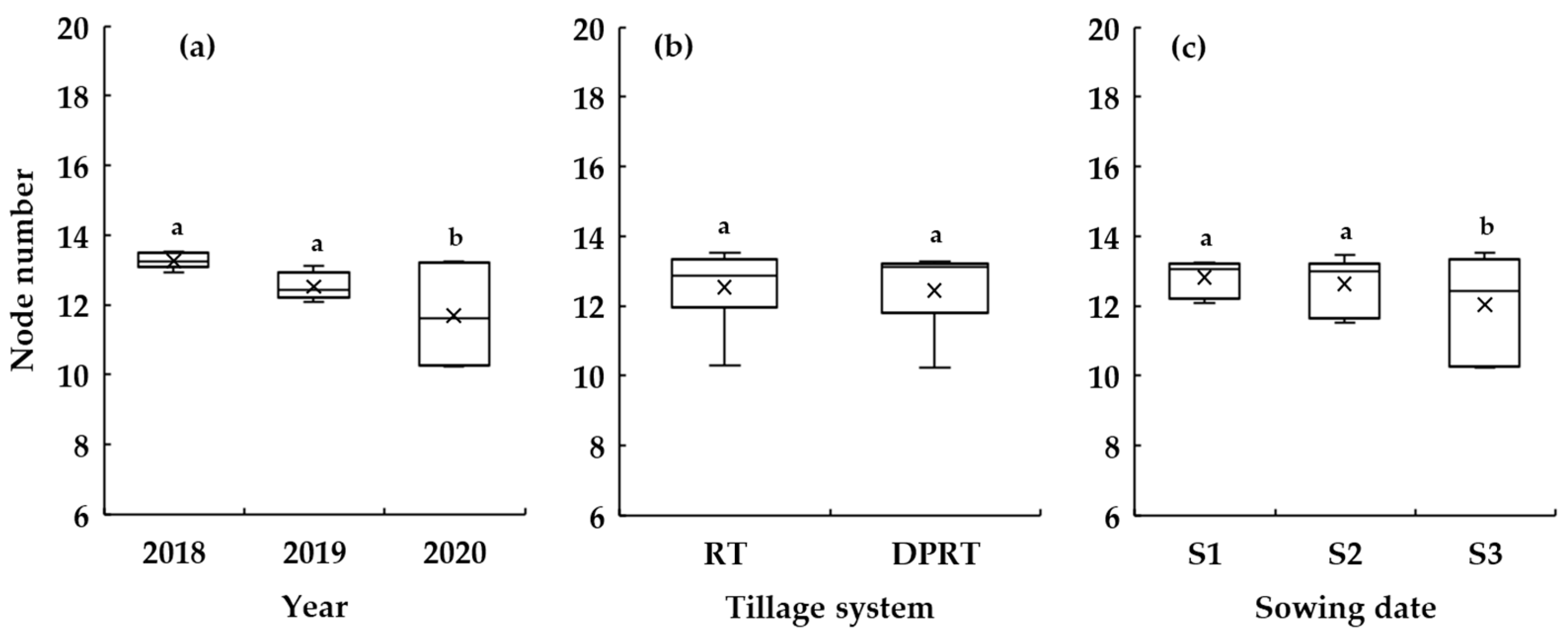Effects of Tillage System, Sowing Date, and Weather Course on Yield of Double-Crop Soybeans Cultivated in Drained Paddy Fields
Abstract
1. Introduction
2. Materials and Methods
2.1. Study Cite Descriptions
2.2. Field Establishments and Treatments
2.3. Crop Managements and Measurements
2.4. Weather during Growing Seasons
2.5. Statistical Analysis
3. Results
3.1. Soil Water Profiles in Different Tillage Systems and Soil Depths
3.2. Crop Phenology and Growth Parameters at Different Tillage Systems and Sowing Dates
3.3. Yield and Related Parameters at Different Tillage Systems and Sowing Dates
4. Discussion
4.1. Sowing Date in Tandem with Weather, Rather than Tillage Systems, Alters Flowering Phenology and Growth
4.2. Tillage Systems and Sowing Date Coupled with Weather Volatility Lead to Yield Variability
5. Conclusions
Author Contributions
Funding
Institutional Review Board Statement
Informed Consent Statement
Data Availability Statement
Acknowledgments
Conflicts of Interest
References
- Shimamura, S.; Mochizuki, T.; Nada, Y. Effect of foliar application of urea on growth and yield in soybean plants grown under continuously flooded conditions. Sci. Bull. Fac. Agric. Kyushu Univ. 2006, 61, 63–67. [Google Scholar]
- Xing, X.; Popp, M.; Chen, P.; Manjarrez-Sandoval, P.; Gbur, E. Evaluation of high-oil and high-protein soybean using component pricing. J. Crop. Improv. 2018, 32, 264–280. [Google Scholar] [CrossRef]
- Kaur, G.; Singh, G.; Moatavalli, P.P.; Nelson, K.A.; Orlowski, L.M.; Golden, B.R. Impacts and management strategies for crop production in waterlogged or flooded soils: A review. Agron. J. 2020, 112, 1475–1501. [Google Scholar] [CrossRef]
- IPCC. Climate Change 2021: The Physical Science Basis. In Contribution of Working Group I to the Sixth Assessment Report of the Intergovernmental Panel on Climate Change; Masson-Delmotte, V., Zhai, P., Pirani, A., Connors, S.L., Péan, C., Berger, S., Caud, N., Chen, Y., Goldfarb, L., Gomis, M.I., et al., Eds.; Cambridge University Press: Cambridge, UK; New York, NY, USA, 2021. [Google Scholar]
- Maekawa, T.; Shimamura, S.; Shimada, S. Effects of short-term waterlogging on soybean nodule nitrogen fixation at different soil reductions and temperatures. Plant. Prod. Sci. 2011, 14, 349–358. [Google Scholar] [CrossRef]
- Bajgain, R.; Kawasaki, Y.; Akamatsu, Y.; Tanaka, Y.; Kawamura, H.; Katsura, K.; Shiraiwa, T. Biomass production and yield of soybean grown under converted paddy fields with excess water during the early growth stage. Field Crop. Res. 2015, 180, 221–227. [Google Scholar] [CrossRef]
- Ploschuk, R.A.; Miralles, D.J.; Striker, G.G. A quantitative review of soybean response to waterlogging: Agronomical, morpho-physiological and anatomical traits of tolerance. Pant Soil 2022, 475, 237–252. [Google Scholar] [CrossRef]
- Smith, R.G.; Menalled, F.D.; Robertson, G.P. Temporal yield variability under conventional and alternative management systems. Agron. J. 2007, 99, 1629–1634. [Google Scholar] [CrossRef]
- Al-Kaisi, M.M.; Archontoulis, S.; Kwaw-Mensah, M. Soybean spatiotemporal yield and economic variability as affected by tillage and crop rotation. Agron. J. 2016, 108, 1267–1280. [Google Scholar] [CrossRef]
- Goulart, R.Z.; Reichert, J.M.; Rodrigues, M.F.; Neto, C.M.; Ebling, E.D. Comparing tillage methods for growing lowland soybean and corn during wetter-than-normal cropping seasons. Paddy Water Environ. 2021, 19, 401–415. [Google Scholar] [CrossRef]
- Linkemer, G.; Board, J.E.; Musgrave, M.E. Waterlogging effects on growth and yield components in late-planted soybean. Crop. Sci. 1998, 38, 1576–1584. [Google Scholar] [CrossRef]
- Kawasaki, Y.; Katsura, K.; Shiraiwa, T. Yield and dry matter dynamics of vegetative and reproductive organs in Japanese and US soybean cultivars. Plant. Prod. Sci. 2018, 21, 349–357. [Google Scholar] [CrossRef]
- Jung, G.; Matsunami, T.; Oki, Y.; Kokubun, M. Effects of waterlogging on nitrogen fixation and photosynthesis in supernodulating soybean cultivar Kanto 100. Plant. Prod. Sci. 2008, 11, 291–297. [Google Scholar] [CrossRef]
- Lee, J.-W.; Hong, S.-Y.; Chang, E.-C.; Suh, M.-S.; Kang, H.-S. Assessment of future climate change over East Asia due to the RCP scenarios downscaled by GRIMs-RMP. Clim. Dyn. 2014, 42, 733–747. [Google Scholar] [CrossRef]
- Leng, G.; Zhang, X.; Huang, M.; Asrar, G.R.; Leung, L.R. The role of climate covariability on crop yields in the conterminous United States. Sci. Rep. 2016, 6, 33160. [Google Scholar] [CrossRef]
- Grassini, P.; Torrion, J.A.; Gassman, K.G.; Yang, H.S.; Specht, J.E. Drivers of spatial and temporal variation in soybean yield and irrigation requirements in western US corn belt. Field Crops Res. 2014, 163, 32–46. [Google Scholar] [CrossRef]
- Li, F.; Zhang, X.; Xu, D.; Ma, Q.; Le, T.; Zhu, M.; Li, C.; Zhu, X.; Guo, W.; Ding, J. No-tillage promotes wheat seedling growth and grain yield compared with plow-rotary tillage in a rice-wheat rotation in the high rainfall region in China. Agronomy 2022, 12, 865. [Google Scholar] [CrossRef]
- Acquah, K.; Chen, Y. Soil compaction from wheel traffic under three tillage systems. Agriculture 2022, 12, 219. [Google Scholar] [CrossRef]
- Goulart, R.Z.; Reichert, J.M.; Rodrigues, M.F. Cropping poorly-drained lowland soils: Alternatives to rice monoculture, their challenges and management strategies. Agric. Syst. 2020, 177, 102715. [Google Scholar] [CrossRef]
- Fiorini, A.; Boselli, R.; Amaducci, S.; Tabaglio, V. Effects of no-tillage on root architecture and root-soil interactions in a three-year crop rotation. Eur. J. Agron. 2018, 99, 156–166. [Google Scholar] [CrossRef]
- Guan, D.; Al-Kaisi, M.M.; Zhang, Y.; Duan, L.; Tan, W. Tillage practices affect biomass and grain yield through regulating root growth and root-bleeding sap and nutrients uptake in summer maize. Field Crops Res. 2014, 157, 89–97. [Google Scholar] [CrossRef]
- Wang, C.; Yan, Z.; Wang, Z.; Batool, M.; El-Badri, A.M.; Bai, F.; Li, Z.; Wang, B.; Zhou, G.; Kuai, J. Subsoil tillage promotes root and shoot growth of rapeseed in paddy fields and dryland in Yangtze River Basin soils. Eur. J. Agron. 2021, 130, 126351. [Google Scholar] [CrossRef]
- Chetan, F.; Chetan, C.; Bogdan, H.; Pop, A.I.; Morau, P.I.; Rusu, T. The effects of management (tillage, fertilization, plant density) on soybean yield and quality in a three-year experiment under Transyvanian Plain climate conditions. Land 2021, 10, 200. [Google Scholar] [CrossRef]
- Da Silava, G.F.; Calonego, J.C.; Luperini, B.C.O.; Chamma, L.; Alves, E.R.; Rodrigues, S.A.; Putti, F.F.; da Silva, V.M.; de Almeida Silva, M. Soil-plant relationships in soybean cultivated under conventional tillage and long-term no-tillage. Agronomy 2022, 12, 697. [Google Scholar] [CrossRef]
- Xiao, L.; Kuhn, N.J.; Zhao, R.; Cao, L. Net effects of conservation agriculture principles on sustainable land use: A synthesis. Glob. Chang. Biol. 2021, 27, 6321–6330. [Google Scholar] [CrossRef]
- Serafin-Andrzejewska, M.; Helios, W.; Jama-Rodzeńska, A.; Kozak, M.; Kotecki, A.; Kuchar, L. Effects of sowing date on soybean development in south-western Poland. Agriculture 2021, 11, 413. [Google Scholar] [CrossRef]
- Wu, T.; Li, J.; Wu, C.; Sun, S.; Mao, T.; Jiang, B.; Hou, W.; Han, T. Analysis of the independent- and interactive-photo-thermal effects on soybean flowering. J. Interg. Agric. 2015, 14, 622–632. [Google Scholar] [CrossRef]
- Gong, L.; Tian, B.; Li, Y.; Wu, S. Phenological changes of soybean in response to climate conditions in frigid region in China over the past decades. Int. J. Plant. Prod. 2021, 15, 363–375. [Google Scholar] [CrossRef]
- He, L.; Jin, N.; Yu, Q. Impacts of climate change and crop management practices on soybean phenology changes in China. Sci. Total Environ. 2020, 707, 135638. [Google Scholar] [CrossRef]
- Zhang, L.; Zhu, L.; Yu, M.; Zhong, M. Warming decreases photosynthates and yield of soybean [Glycine max (L.) Merrill] in the north China plain. Crop. J. 2016, 4, 139–146. [Google Scholar] [CrossRef]
- Nelson, D.W.; Sommers, L.E. Total carbon, organic carbon, and organic matter. In Methods of Soil Analysis, Part. 3: Chemical Methods; Sparks, D.L., Page, A.L., Helmk, P.A., Loeppert, R.H., Soltanpour, P.N., Tabatabai, M.A., Johnston, C.T., Sumner, M.E., Eds.; ASA and SSSA: Baltimore, MD, USA, 1996; pp. 961–1010. [Google Scholar]
- Kuo, S. Phosphorus. In Methods of Soil Analysis, Part. 3: Chemical Methods; Sparks, D.L., Page, A.L., Helmk, P.A., Loeppert, R.H., Soltanpour, P.N., Tabatabai, M.A., Johnston, C.T., Sumner, M.E., Eds.; ASA and SSSA: Baltimore, MD, USA, 1996; pp. 869–919. [Google Scholar]
- Sumner, M.E.; Miller, W.P. Cation exchange capacity and exchange coefficients. In Methods of Soil Analysis, Part. 3: Chemical Methods; Sparks, D.L., Page, A.L., Helmk, P.A., Loeppert, R.H., Soltanpour, P.N., Tabatabai, M.A., Johnston, C.T., Sumner, M.E., Eds.; ASA and SSSA: Baltimore, MD, USA, 1996; pp. 1201–1229. [Google Scholar]
- Gee, G.W.; Bauder, J.W. Particle-size analysis. In Methods of Soil Analysis, Part. 1: Physical and Mineralogical Methods; Campbell, G.S., Nielsen, D.R., Jackson, R.D., Klute, A., Mortland, M.M., Eds.; ASA and SSSA: Baltimore, MD, USA, 1986; pp. 383–412. [Google Scholar]
- Fehr, W.R.; Caviness, C.E. Stage of soybean development. In Iowa Agriculture and Economics Experiment Station Report 80; Iowa State University: Ames, IA, USA, 1977. [Google Scholar]
- Liu, X.; Jin, J.; Wang, G.; Herbert, S.J. Soybean yield physiology and development of high-yield practices in Northeast China. Field Crop. Res. 2008, 105, 157–171. [Google Scholar] [CrossRef]
- Sakurai, G.; Izumi, T.; Yokozawa, M. Varying temporal and spatial effects of climate on maize and soybean affect yield prediction. Clim. Res. 2011, 49, 143–154. [Google Scholar] [CrossRef]
- Tacarindua Custodio, R.P.; Shiraiwa, T.; Homma, K.; Kumagai, E.; Sameshima, R. The effects of increased temperature on crop growth and yield of soybean grown in a temperature gradient chamber. Field Crop. Res. 2013, 154, 74–81. [Google Scholar] [CrossRef]
- Burkey, K.; Tisdale, R.; Zobel, R.; Ray, S.; Pursley, W. Interactive effects of elevated ozone and temperature on growth and yield of soybean (Glycine max (L.) Merrill) under field conditions. Agronomy 2020, 10, 1083. [Google Scholar] [CrossRef]
- Maitree, M.; Toyota, M. A high seed yield and associated attributes of dry matter production achieved by recent Japanese soybean cultivars. Pant Prod. Sci. 2017, 20, 193–204. [Google Scholar] [CrossRef]
- Krisnawati, A.; Nuryati; Adie, M.M. Agronomic tolerance changes of soybean genotypes under waterlogged condition. IOP Conf. Ser. Earth Environ. Sci. 2021, 648, 012046. [Google Scholar] [CrossRef]
- Nishioka, H.; Okumura, T. Influence of sowing time and nitrogen topdressing at the flowering stage on the yield and pod character of green soybean (Glycine max (L.) Merrill). Plant. Prod. Sci. 2008, 11, 507–513. [Google Scholar] [CrossRef][Green Version]
- Shimamura, S.; Mochizuki, T.; Nada, Y.; Fukuyama, M. Secondary aerenchyma formation and its relation to nitrogen fixation in root nodules od soybean plants (Glycine max) grown under flooded conditions. Plant. Prod. Sci. 2002, 5, 294–300. [Google Scholar] [CrossRef]
- Leuthold, S.J.; Wendroth, O.; Salmeron, M.; Poffenbarger, H. Weather-dependent relationships between topographic variables and yield of maize and soybean. Field Crops Res. 2022, 276, 108368. [Google Scholar] [CrossRef]
- O’Brien, P.L.; Hatfield, J.L. Pant-to-plant biomass and yield variability in corn-soybean rotations under three tillage regimes. Agron. J. 2021, 113, 370–390. [Google Scholar] [CrossRef]
- Egli, D.B. Crop growth rate and the establishment of sink size: A comparison of maize and soybean. J. Crop. Improv. 2019, 33, 346382. [Google Scholar] [CrossRef]
- Matsunami, T.; Jung, G.H.; Oki, Y.; Kokubun, M. Effect of waterlogging during vegetative stage on growth and yield in supernodulating soybean cultivar Sakukei 4. Plant. Prod. Sci. 2007, 10, 112–121. [Google Scholar] [CrossRef]







| Parameters | Values |
|---|---|
| pH (1:5) | 6.83 |
| Total C (g kg−1) | 11.0 |
| Total N (g kg−1) | 1.2 |
| Available P (mg P2O5 kg−1) | 5.6 |
| CEC (cmol kg−1) | 7.2 |
| Texture | Silty clay loam |
| Sand (g kg−1) | 105 |
| Silt (g kg−1) | 608 |
| Clay (g kg−1) | 287 |
| Year | Crop Stage | Mean Temperature (°C) | Rainfall (mm) | Rainfall Events (day) | Sunshine Duration (h d−1) | ||||||||
|---|---|---|---|---|---|---|---|---|---|---|---|---|---|
| S1 | S2 | S3 | S1 | S2 | S3 | S1 | S2 | S3 | S1 | S2 | S3 | ||
| 2018 | WS | 23.4 | 23.3 | 22.4 | 1437 | 1415 | 1130 | 42 | 39 | 31 | 6.8 | 6.7 | 7.3 |
| 2019 | WS | 23.5 | 23.2 | 23.1 | 732 | 623 | 572 | 44 | 40 | 36 | 5.6 | 5.5 | 5.6 |
| 2020 | WS | 22.6 | 22.9 | 22.9 | 1559 | 1456 | 1206 | 51 | 45 | 37 | 5.0 | 4.8 | 5.2 |
| Normal (1991–2020) | WS | 22.8 | 22.7 | 22.0 | 931 | 840 | 647 | - | - | - | 5.5 | 5.6 | 5.9 |
| 2018 | S–R2 | 26.7 | 28.4 | 29.5 | 307 | 304 | 90 | 11 | 9 | 4 | 7.1 | 7.3 | 9.0 |
| R2–R5 | 28.9 | 26.6 | 23.7 | 90 | 470 | 885 | 4 | 13 | 11 | 8.1 | 6.1 | 4.8 | |
| R5–R8 | 19.0 | 17.4 | 16.4 | 1040 | 641 | 155 | 27 | 17 | 16 | 5.9 | 6.4 | 6.7 | |
| 2019 | S–R2 | 24.7 | 26.3 | 27.4 | 352 | 261 | 222 | 17 | 16 | 14 | 5.4 | 5.2 | 5.7 |
| R2–R5 | 28.3 | 26.0 | 24.1 | 30 | 48 | 68 | 5 | 5 | 9 | 7.0 | 5.4 | 2.9 | |
| R5–R8 | 21.3 | 20.3 | 19.8 | 350 | 314 | 282 | 22 | 19 | 13 | 5.2 | 5.7 | 6.1 | |
| 2020 | S–R2 | 23.7 | 24.4 | 26.2 | 637 | 1206 | 956 | 26 | 28 | 21 | 3.5 | 2.5 | 4.0 |
| R2–R5 | 27.5 | 28.1 | 25.0 | 661 | 65 | 178 | 7 | 3 | 8 | 5.5 | 7.2 | 4.4 | |
| R5–R8 | 20.2 | 19.8 | 18.8 | 261 | 185 | 72 | 18 | 14 | 8 | 6.1 | 6.0 | 6.6 | |
| Normal (1991–2020) | S–R2 | 24.9 | 26.0 | 26.8 | 438 | 448 | 371 | - | - | - | 4.9 | 4.9 | 5.5 |
| R2–R5 | 26.8 | 25.5 | 24.1 | 210 | 185 | 129 | - | - | - | 5.5 | 5.2 | 5.3 | |
| R5–R8 | 19.9 | 18.6 | 17.5 | 284 | 208 | 147 | - | - | - | 6.1 | 6.3 | 6.4 | |
| Year | Tillage | SD | LAI (m2 m−2) | SLA (cm2 g−1) | NAR (g m−2 d−1) | CGR (g m−2 d−1) | AGBM (g m−2) | |||
|---|---|---|---|---|---|---|---|---|---|---|
| R2 | R5 | R2 | R5 | R2–R5 | R2–R5 | R5 | R8 | |||
| 2018 | RT | S1 | 2.4 bc | 4.1 b | 187.7 ab | 134.3 c | 9.17 a | 29.59 a | 902.1 a | 911.2 a |
| S2 | 2.1 c | 4.5 b | 153.9 b | 181.0 bc | 6.00 abc | 18.90 abc | 774.3 a | 832.6 ab | ||
| S3 | 3.6 a | 4.9 ab | 252.0 a | 252.2 ab | 3.30 bc | 13.74 bc | 572.4 b | 648.1 b | ||
| DPRT | S1 | 2.8 b | 4.8 ab | 207.8 a | 160.3 c | 7.45 ab | 27.54 ab | 901.7 a | 732.8 ab | |
| S2 | 2.3 bc | 4.6 ab | 209.5 a | 200.0 bc | 5.56 abc | 18.07 abc | 706.0 a | 765.2 ab | ||
| S3 | 3.7 a | 5.4 a | 258.3 a | 327.4 a | 1.96 c | 8.85 c | 498.1 b | 585.2 b | ||
| 2019 | RT | S1 | 6.1 a | 6.3 b | 348.2 b | 328.1 a | 3.76 b | 23.29 ab | 602.5 a | 840.8 a |
| S2 | 6.4 a | 7.1 a | 512.7 a | 323.2 a | 2.84 b | 19.12 b | 639.8 a | 697.7 b | ||
| S3 | 4.7 b | 6.1 b | 500.7 a | 375.8 a | 2.61 b | 13.96 b | 431.0 b | 537.7 c | ||
| DPRT | S1 | 6.0 a | 6.2 b | 460.8 a | 309.5 a | 5.98 a | 36.26 a | 627.7 a | 747.2 ab | |
| S2 | 6.2 a | 7.2 a | 504.4 a | 383.9 a | 2.37 b | 15.71 b | 559.8 a | 684.4 b | ||
| S3 | 4.5 b | 5.5 c | 508.6 a | 355.2 a | 2.75 b | 13.73 b | 408.3 b | 486.4 c | ||
| 2020 | RT | S1 | 5.4 a | 6.3 a | 390.0 b | 377.0 b | 1.93 a | 11.24 a | 556.6 a | 628.5 a |
| S2 | 5.2 ab | 6.4 a | 632.9 a | 441.0 ab | 2.49 a | 14.23 a | 419.2 ab | 645.3 ab | ||
| S3 | 4.4 b | 5.6 a | 647.7 a | 606.3 a | 1.65 a | 8.18 a | 261.6 b | 408.3 bc | ||
| DPRT | S1 | 5.0 ab | 6.2 a | 511.2 a | 386.6 b | 2.54 a | 14.14 a | 523.6 a | 347.0 bc | |
| S2 | 4.8 ab | 6.3 a | 660.6 a | 516.1 a | 2.26 a | 12.72 a | 394.0 ab | 497.2 ab | ||
| S3 | 4.2 b | 5.7 a | 569.6 a | 603.5 a | 1.58 a | 7.76 a | 267.7 b | 335.4 c | ||
| ANOVA results | ||||||||||
| Year (Y) | 0.0003 | <0.0001 | 0.0004 | 0.0003 | 0.0009 | 0.0079 | 0.0021 | 0.0045 | ||
| Tillage (T) | 0.5363 | 0.4821 | 0.3038 | 0.2004 | 0.7505 | 0.9010 | 0.4224 | 0.0041 | ||
| Sowing (S) | 0.0062 | 0.0118 | 0.0004 | <0.0001 | 0.0001 | 0.0002 | <0.0001 | <0.0001 | ||
| Y × T | 0.0947 | 0.0474 | 0.9757 | 0.7457 | 0.3022 | 0.6063 | 0.9369 | 0.3598 | ||
| Y × S | <0.0001 | 0.0002 | 0.0318 | 0.0415 | 0.0063 | 0.1667 | 0.5486 | 0.1724 | ||
| T × S | 0.8782 | 0.8408 | 0.1170 | 0.5552 | 0.6982 | 0.3439 | 0.8316 | 0.0345 | ||
| Y × T × S | 0.9709 | 0.6642 | 0.4838 | 0.7002 | 0.6597 | 0.6898 | 0.9791 | 0.7279 | ||
| Year | Tillage | SD | Pod No. (hill−1) | Seed No. (pod−1) | Fine Seed No. (hill−1) | 100 Seeds wt. (g) | Yield (g m−2) |
|---|---|---|---|---|---|---|---|
| 2018 | RT | S1 | 86.4 a | 1.82 a | 153.6 a | 25.3 b | 552.0 a |
| S2 | 78.4 ab | 1.74 bc | 130.1 b | 26.6 b | 494.7 ab | ||
| S3 | 62.1 c | 1.65 c | 98.2 c | 26.9 ab | 377.0 b | ||
| DPRT | S1 | 75.7 ab | 1.77 ab | 130.5 ab | 25.5 b | 479.4 a | |
| S2 | 66.4 c | 1.68 c | 106.7 c | 28.5 a | 465.9 a | ||
| S3 | 62.3 c | 1.67 c | 97.2 c | 26.7 b | 373.4 a | ||
| 2019 | RT | S1 | 89.6 a | 1.76 a | 158.5 a | 23.0 bc | 492.4 a |
| S2 | 73.0 b | 1.72 a | 119.7 b | 25.6 ab | 404.3 b | ||
| S3 | 55.0 c | 1.73 a | 92.9 cd | 25.0 abc | 308.6 c | ||
| DPRT | S1 | 79.7 ab | 1.72 a | 135.2 ab | 22.1 c | 405.1 b | |
| S2 | 70.7 b | 1.70 a | 114.9 bc | 26.2 a | 400.3 b | ||
| S3 | 49.2 c | 1.72 a | 82.0 d | 25.9 ab | 286.3 c | ||
| 2020 | RT | S1 | 59.3 a | 1.98 a | 110.0 a | 21.3 ab | 329.3 a |
| S2 | 54.3 ab | 1.94 a | 99.2 ab | 22.8 a | 323.8 a | ||
| S3 | 41.6 bcd | 1.97 a | 72.5 bc | 19.1 c | 198.8 b | ||
| DPRT | S1 | 30.4 d | 1.91 a | 44.7 d | 20.0 b | 123.8 c | |
| S2 | 48.6 abc | 1.94 a | 87.0 abc | 22.5 a | 280.2 a | ||
| S3 | 39.7 cd | 1.97 a | 70.3 cd | 19.3 bc | 193.2 bc | ||
| ANOVA results | |||||||
| Year (Y) | 0.0054 | 0.0001 | 0.0073 | 0.0005 | 0.0018 | ||
| Tillage (T) | 0.0011 | 0.2999 | 0.0001 | 0.6588 | 0.0014 | ||
| Sowing (S) | <0.0001 | 0.1928 | <0.0001 | <0.0001 | <0.0001 | ||
| Y × T | 0.2710 | 0.9911 | 0.0646 | 0.4045 | 0.1308 | ||
| Y × S | 0.0001 | 0.2208 | 0.0003 | 0.0034 | 0.0035 | ||
| T × S | 0.0066 | 0.65598 | 0.0029 | 0.2070 | 0.0009 | ||
| Y × T × S | 0.0828 | 0.9571 | 0.0736 | 0.6648 | 0.2317 | ||
Publisher’s Note: MDPI stays neutral with regard to jurisdictional claims in published maps and institutional affiliations. |
© 2022 by the authors. Licensee MDPI, Basel, Switzerland. This article is an open access article distributed under the terms and conditions of the Creative Commons Attribution (CC BY) license (https://creativecommons.org/licenses/by/4.0/).
Share and Cite
Han, S.-S.; Park, H.-J.; Shin, T.; Ko, J.; Choi, W.-J.; Lee, Y.-H.; Bae, H.-S.; Ahn, S.-H.; Youn, J.-T.; Kim, H.-Y. Effects of Tillage System, Sowing Date, and Weather Course on Yield of Double-Crop Soybeans Cultivated in Drained Paddy Fields. Agronomy 2022, 12, 1901. https://doi.org/10.3390/agronomy12081901
Han S-S, Park H-J, Shin T, Ko J, Choi W-J, Lee Y-H, Bae H-S, Ahn S-H, Youn J-T, Kim H-Y. Effects of Tillage System, Sowing Date, and Weather Course on Yield of Double-Crop Soybeans Cultivated in Drained Paddy Fields. Agronomy. 2022; 12(8):1901. https://doi.org/10.3390/agronomy12081901
Chicago/Turabian StyleHan, Soon-Suk, Hyun-Jin Park, Taehwan Shin, Jonghan Ko, Woo-Jung Choi, Yun-Ho Lee, Hui-Su Bae, Seung-Hyun Ahn, Jong-Tak Youn, and Han-Yong Kim. 2022. "Effects of Tillage System, Sowing Date, and Weather Course on Yield of Double-Crop Soybeans Cultivated in Drained Paddy Fields" Agronomy 12, no. 8: 1901. https://doi.org/10.3390/agronomy12081901
APA StyleHan, S.-S., Park, H.-J., Shin, T., Ko, J., Choi, W.-J., Lee, Y.-H., Bae, H.-S., Ahn, S.-H., Youn, J.-T., & Kim, H.-Y. (2022). Effects of Tillage System, Sowing Date, and Weather Course on Yield of Double-Crop Soybeans Cultivated in Drained Paddy Fields. Agronomy, 12(8), 1901. https://doi.org/10.3390/agronomy12081901







